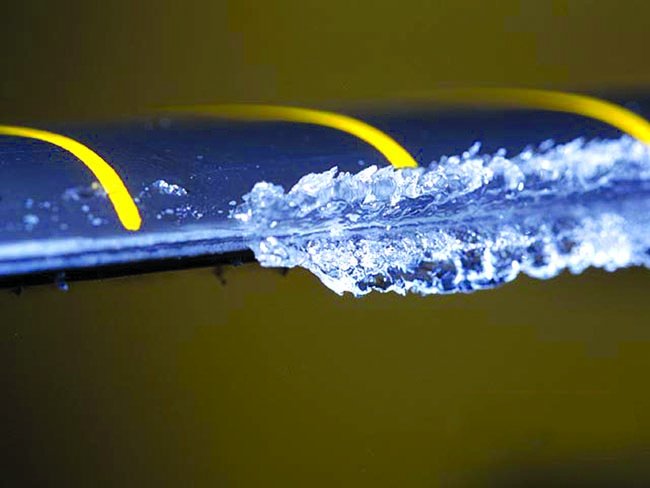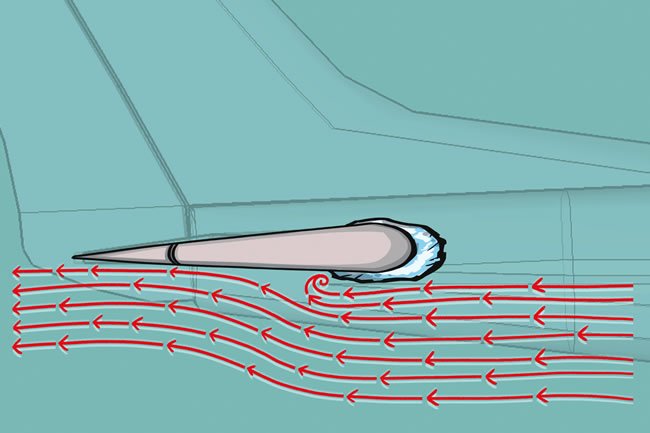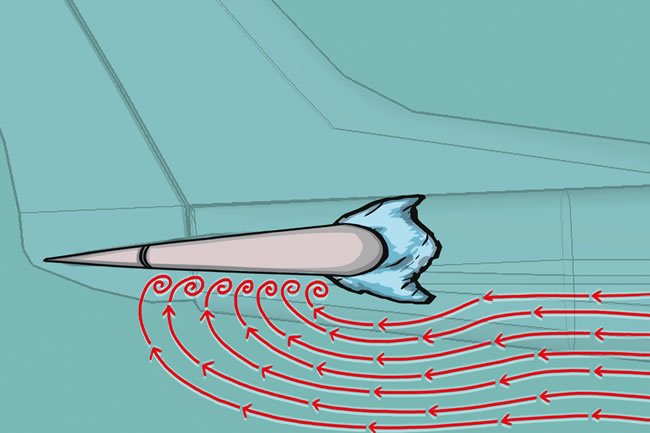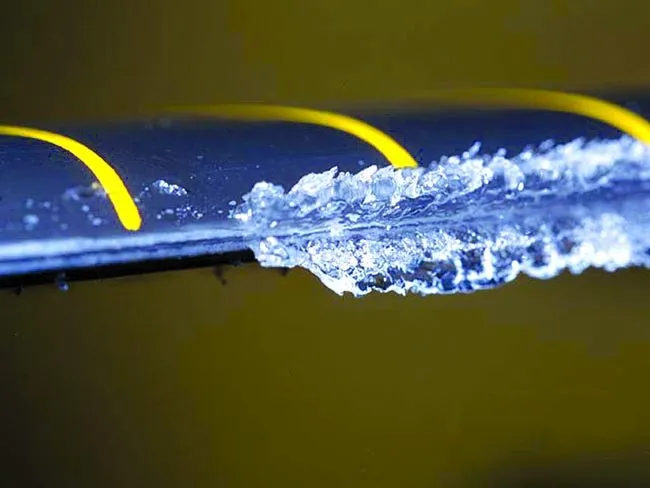
Every year structural icing claims a small but steady number of airplanes. Many of the accidents are on approach in clear air—after the airplane has already collected a load of ice. We look at it afterwards and wonder—the airplane had been doing fine—why did it crash well after it escaped from icing conditions?
Full-scale airframe ice flight testing and our ability to reconstruct icing-related accidents have gotten more sophisticated. Consequently, we’ve learned that tail stalls, rather than wing stalls, may be the culprit in crashes that occur during the descent or approach phase of flight. This matters because pilots have been taught how to recover from wing stalls (lower the nose, add power) but not from tail stalls, and the recovery from tail stalls is precisely the opposite (raise the nose, raise the flaps, reduce power). The consequence of using the wrong recovery technique can be fatal.
The infamous 2009 Colgan Air Dash 8 crash on approach in icing conditions to Buffalo, New York is believed, by some commentators, to have been caused by an experienced crew—having recently been through tail stall training—mistakenly believing they were experiencing a tail, rather than wing stall. The captain pulled back on the yoke and the first officer retracted the flaps.
Since recovery technique varies, you can’t recover if you don’t know which airfoil has stalled.
Radius Matters
If the opportunity presents itself, the next time you see an airplane that has landed with ice on the airframe, compare the buildup on the unprotected areas of the wing and tail. Also take a look at the antennas. You might be surprised by the significantly greater amount of ice on the tail and antennas than that on the wing.
Very simply: the smaller the radius of the leading edge, the faster and wider the ice buildup is. Therefore, the horizontal stabilizer collects a greater percentage of its radius in ice than does the wing. Even with but a half inch of ice on the wing there may be an inch or more of ice on the tail.
To make matters worse, ice buildups tend also to take on interesting shapes—they frequently branch out from the leading edge, forming what appears in cross section to be horns. The net effect is that the smaller airfoil—the tail—gets relatively more ice than the wing, so the flow over it is more disturbed than the flow over the wing.
The shape of ice buildups on the wings is a far bigger problem to an airplane than the weight of the ice. The wing and tail create lift partially because of a smooth airflow along the chord of the airfoil. When there is ice on the front, the airflow across the lifting surface (the top of the wing, the bottom of the tail) is no longer attached to the surface after crossing that ice buildup.
Aft of the ice there is airflow separation from the surface, creating what amounts to a void that has to be filled. The air coming over the ice rotates toward the airfoil and then flows forward, creating a rotor or vortex of disturbed air in the area of flow separation. See the illustration on the top-left of the next page.

Loss of Lift
This reverse flow means that portion of the tail’s airfoil is stalled—not providing lift. The size of this disturbed area or airflow separation matters. With more ice there’s more disturbed airflow. The higher the angle of attack, the greater the size of the area of disturbed airflow. If the area of disturbed airflow gets large enough, the entire airfoil stalls. Before that, if it moves aft far enough to cross the hinge line of the elevator, it has the effect of tending to pull the elevator toward it. See the illustration at the top-right of the next page.
This all becomes important because the tail of an airplane is usually lifting downward to overcome the nose-down pitching moment of the wing in normal flight. Remember ground school that the wing’s center of lift is usually behind the center of gravity. As the wing lifts upwards, the center of gravity pulls the front portion of the wing down—nose down force—which the horizontal tail overcomes by lifting downward.
In cruising flight icing is not as much of a concern for the tail as it is for the wing because the tail is at a low angle of attack, nowhere near its performance limits, so the burble or rotor behind the ice buildup stays close to the buildup and the vast majority of the tail has airflow that is attached and effective.
In cruise configuration, the problem with ice buildup is sheer magnitude on the airframe and the wings. That’s where you get so much drag and lose so much lift that you can’t hold altitude, the stall speed increases and you may either sink into the ground or stall the airplane and lose control.
Tail Stall Tale
A tailplane stall event typically begins with the airplane picking up some ice. As the pilot begins the approach, he or she selects approach flaps and notices that it’s difficult to trim the airplane and the elevator feels lighter than usual. The control wheel will move forward very easily but it’s difficult to pull it back. Often some mild pilot induced oscillation (PIO) begins that may be difficult to fully damp.
Struggling like this through the approach, once the runway is made, the pilot selects full flaps. Wham—suddenly, the airplane pitches down 45 degrees, the pilot tries to pull back on the yoke, but it’s immovable and the airplane crashes.
Either the tail stalled, or the flow separation under the tail moved so far aft that it reached the elevator and caused the elevator to deflect radically downward. The result is the same: the nose pitches down violently and recovery is the same in either case.

Flaps
Flap extension does two things to an ice-contaminated horizontal stabilizer, both bad. It changes the airflow aft of the wings, deflecting it downward, which causes increased downwash over the tail, increasing its angle of attack. This is depicted on the facing page and it happens to both high- and low-wing airplanes.
With increased angle of attack and an ice buildup on the leading edge, the flow separation on the underside of the tail, the lifting part, is worse, and the area of disturbed air, gets bigger and moves aft.
Flap deflection also moves the center of lift of the wing aft, further from the center of gravity. This causes an increase in nose-down pitching force. To compensate, the tail must exert greater downward force, thus increasing its angle of attack still more and causing it to work nearer to its performance limit.
Increasing the horizontal stabilizer’s angle of attack increases the area of flow separation behind the ice buildup. When the area of flow separation reaches the hinge line for the elevator the relative low pressure of the flow separation or rotor acts to pull the elevator toward it, that is, downward.

Yoke Movement
With the normal, small changes in pitch of the airplane on approach, the size of the disturbed airflow area under the tail, behind the ice buildup, changes accordingly. The pilot feels a buffeting in the wheel—unlike a pre-wing stall buffet that is felt, quite literally, through the seat of the pants.
The changing amount of “pull” on the elevator causes changing forces to feed back to the yoke. The pilot feels that the controls are light—easy to move forward (elevator down into the area of flow separation and lower pressure), but difficult to pull aft. It may be difficult to trim the airplane in pitch.
The pilot fights this and PIO begins. PIO adds to the rapidly changing angle of attack of the elevator, further changing the size of the area of airflow separation, and further increasing the rate of change to the downward-acting force on the elevator. Things are building on themselves, but the pilot may still be able to keep the airplane mostly under control.
When full flaps are added, the combination of increased downwash and the aft movement of the center of lift further increase the angle of attack of the elevator. The area of flow separation may get so big that either the horizontal tail simply stalls and quits lifting downward, allowing the nose-down pitching moment of the wing to act unopposed, or the elevator is physically pulled downward into the area of flow separation. In either case, the pitch down is sudden and violent. Pilots who have experienced it describe either getting light in their seats or actually being thrown against the seat belt.
Recovery
Recovery requires reducing the angle of attack of the horizontal stabilizer and getting the elevator away from the area of flow separation. That means raising the flaps, at least to the previous position. It also means physically pulling the elevator away from the area of flow separation by pulling back on the wheel.
There are reports that on some commuter turboprops the force necessary to pull the wheel back and get the nose up to the horizon may be as high as 400 pounds. The more realistic load for smaller aircraft is as high as the 100 to 125 pound range. That is still a huge amount of force. Be prepared for it.
Power
Adding power makes a tail stall from ice worse. Power is always destabilizing to an airplane, although with no ice, the aerodynamic design of the airplane easily handles the power available. Adding power adds to the downwash effect, increasing the angle of attack of the tail. While the effect of a power increase on increasing the size of the area of airflow separation aft of the ice buildup is not as great as flap deployment, a power increase still increases the size of the area of flow separation. So, in the event of a tail stall, while you are retracting the flaps and pulling for all you are worth, reduce power as much as you can, counterintuitive though that may be.
Note also that increasing speed increases the area of flow separation under the horizontal stabilizer. It doesn’t seem to matter in cruise because the tail is at a very low angle of attack; however, once the flaps have been deployed, a speed increase will make matters worse. That is exactly opposite to the technique of dealing with wing icing and the need to stay well above the stall speed for the wing. With flap deflection in the equation, additional speed does not help. The solution? If you get into ice, leave the flaps up.
Diagnosis and Cure
How do you know if the icing problem you are wrestling is an impending wing or tail stall? There are some general rules. If the flaps are up and you are in cruise configuration, the pressing concern is wing stall. To the extent it gives any warning it will be in the form of airframe buffet. If you feel shaking through the seat of your pants, the problem is probably the wing—as redesigned by ice—approaching its critical angle of attack.
An impending tail stall gives a different set of warnings. If the pitch control gets “lighter,” particularly if it becomes easier to push forward on the yoke than it is to pull aft, be suspicious. It may become difficult—if not impossible—to trim the airplane and you may enter PIO. Further warning is given via buffeting in the control wheel itself, not in the airframe. If you have any amount of flap deployed and you experience shaking in the control wheel, it’s a good bet that it’s the tail that’s at risk of stalling.
The first defense against a tail stall from ice is to, obviously, avoid the ice. Unfortunately, that’s not always realistic. So, if you have ice on the airplane, leave the flaps up on the approach and all the way through landing. If the POH has a speed for approaching with ice contamination, use it. Otherwise, fly fast and do not close the throttle until the wheels are rolling on the ground (if you reduce power in the flare you may go from being above the power on stalling speed with ice to below the power off stalling speed with ice—a wing stall problem). Too many pilots have figured they had the landing nailed, pulled the power back in the flare and promptly hit so hard they damaged the airplane. If a power setting has worked all the way through the approach, don’t mess with success.
Also, if you picked up the ice at altitude and you’ve descended to a lower, ice-free temperature and the airplane is still reasonably controllable, consider staying there for a bit to see if you can reduce the ice through melting or sublimation.
If you miss the warning signs and do end up with a tail stall, retract flaps if deployed, reduce power and apply up elevator, possibly against extreme resistance.
After you taxi in and your pulse rate returns to double digits, remind yourself that ice is for drinks.
Rick Durden, accomplished pilot and attorney and senior editor for sister publication, Aviation Consumer, believes ice is for cocktails.





